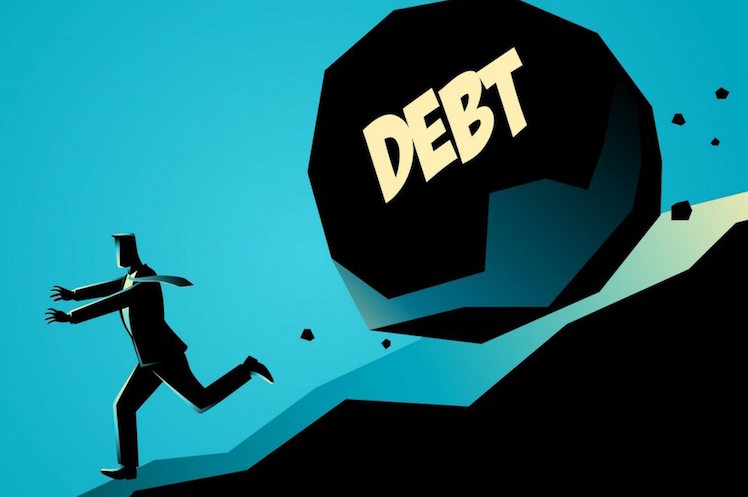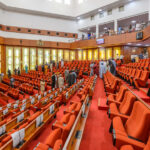Within half a century, Nigeria’s total external debt stock – due but unpaid foreign loans plus accrued interest arrears – rose from less than 1 billion dollars in 1970 to over 70 billion dollars as of 2021. More than two-thirds of this are owed to multilateral institutions: the World Bank, the International Monetary Fund and the African Development Bank – and less than 10 per cent to China, while the rest is to other bilateral lenders.
A caveat on the Chinese credit: according to information from Nigeria’s debt management office, loans from China are wholly tied to 15 infrastructure projects ranging from transportation, water and telecommunications to electricity. At 2.5 per cent interest rates, the debts are expected to be fully paid back within 30 years: 20 years maturity plus seven years grace period.
The nation’s current foreign debt level, in addition to raising the risk of sovereign default (that is the failure of the government to pay its debt), is also absorbing and sucking up the entire government budgetary space such that the country has little room to spend on other pressing national needs.
Concerning resolving the debt crisis, the situation raises two pertinent questions. First, what are the forces at the root of shaping Nigeria’s debt profile? Second, what can be done to reverse the government finances from sinking deeper into the red? Before addressing these questions (in the later part) in detail, we proceed by laying out a context as follows.
- Hold us responsible for desired new Nigeria, Obi, Baba-Ahmed
- Turkish/Syrian earthquake: JNI calls for donations as death toll rises to 22,765
In a setting of zero public sector corruption (practically impossible), who benefits the most from government spending? And who loses out whenever the government cuts its spending? Both questions share the same answer: the poor. This is because state-owned, state-funded, and state-run public goods such as schools, hospitals, dams, electricity, roads, etc – are substantially relied upon by the poor as a means of raising welfare levels in that the rich can afford or buy education and healthcare services from private schools and private hospitals, respectively. However, in the presence of corruption – the reality on the ground – the primary beneficiaries of government budgets in addition to the poor are typically the elected and the unelected corrupt government officials and bureaucrats. Given that they wield the levers of power, government budgets are often used as tools (instead of instruments of delivering public goods and services) to leak way resources from public tills to private tills, thus providing more grounds for borrowing and mounting public debt to finance and grease the greed of corruption. There is therefore no question that government spending is strongly connected to the national debt.
Like other nations, Nigeria borrows from the rest of the world. Its budget is significantly tied to changes in world oil prices, hence, in periods of falling oil revenues, the government usually rushes to lenders for loans to finance deficits otherwise, the decline in revenues will always come at the expense of investments in infrastructure – accumulation of physical capital stock such as roads, new schools, hospitals, dams etc. This is because the government must pay its workers and fund its operations including providing national security. In other words, the government chooses to borrow in periods of negative shocks to oil prices so that its recurrent expenditure will have to hold up so that workers are not shaded off from public employment.
The forces at the root of rising Nigeria’s foreign debt
In our opinion, two main forces are driving the rise of the external national debt.
First, the rate at which the country borrows. According to the World Bank’s International Debt Statistics, for the past 50 years, Nigeria was on average withdrawing at the speed of more than $2 billion a year from its loan commitments. However, the significant rise in the debt stock is attributed to disbursements on external loans within the last decade. In the lead-up to the 2015 general elections, about $9 billion – five times the average initial withdrawals – was pinched in 2014. Similarly, in the two years (2017 and 2018) preceding the last general elections, close to $25 billion was drawn. This pattern could be linked to the incidence voracity effect – a notion that the absence of strong political and legal institutions, combined with the presence of multiple powerful groups fosters the mismanagement of public finance, possibly to finance political campaigns in attempts to reinforce their hold (tighten their grip) on power as both presidents, in the case of Nigeria, were incumbents seeking re-elections before the massive debt accumulations.
The second reason behind Nigeria’s expanding debt stock has been the debt management strategy, especially how the debt was serviced by various regimes. Please note that to service debt is to pay down the debt stock. That includes paying back part of the principal and the accrued interest arrears. For instance, for the past five decades, Nigeria has been servicing its debt at an annual average rate of roughly 15 per cent (roughly $2 billion) of its total external debt. More so, between 2007 and 2014 – when world oil prices hovered around $100 per barrel, offering an opportunity for Nigeria to significantly lower its debt level – debt service payment was ironically at its lowest: an average of less than $1 billion per year.
Shedding more light on this via a 2005 CGD note, Todd Moss aptly captured how Nigeria’s poor management of its debt in the past swelled the nation’s debt level:
“Unlike many indebted poor countries, Nigeria’s debts are not from massive over-borrowing and then wasteful spending. The initial loans to Nigeria were fairly small amounts and undertaken by the civilian Shagari government in the early 1980s. The subsequent escalation of debt stock is primarily the result of accrued arrears, interest, penalties, and export credit defaults accumulated by the military governments that ruled the country from 1984-99.”
However, in fairness to the military juntas, they built some of the major projects housing the current democratic system in the country such as the parliamentary building, the presidential villa or Aso Rock (Nigeria’s equivalent of the US White House and the UK’s 10 Downing Street), the federal capital and the creation of the country’s 36 states and over seven hundred local councils. Other notable infrastructure projects executed by the military governments include the country’s three national refineries, dams, universities, roads, airports, major bridges, and more.
Should the citizens feel a sense of danger?
Rising debt levels should not raise immediate concerns if that comes with a falling debt-to-GDP ratio. The ratio, defined as the total debt stock divided by the size of the economy, tells us the fraction of the economy being eaten up by debt and the extent to which the debt benefits the economy. If a nation’s debt stock is rising and at the same time its debt-to-GDP ratio is declining, it means the country is making the most of its debt and that should not be a cause for alarm.
However, a nation can offset part of its debt and still have a high debt-to-GDP ratio. For instance, if the country uses part of its capital expenditure or all of it to write down part of its debt, that will no doubt slash the debt stock and the country’s balance sheet will look cleaner than it otherwise would have been. But diverting and spending capital expenditure on the debt has stripped the nation of the desperately needed resources to grease the engine of growth. As a result, growth will shrink and the ratio of debt to GDP will rise, a sign of an unhealthy economy. Nonetheless, incurring more debt in the short run and using that to invest in high-return infrastructure projects will potentially lower the debt to- GDP ratio in the long run.
The early 1980s collapse in world oil prices coincided with soaring Nigeria’s debt to GDP ratio. It rose from about 4 per cent in 1981 to a peak of more than 90 per cent in 1993; and then within two decades, it fell back to roughly 4 per cent as of 2012. However, it is firmly rising again. Between 2013 and 2020, it ballooned by over 250 per cent: more than 14 per cent in 2020. But should this be a concern? To find an answer, a debt study by two Harvard professors of economics (Carmen Reinhart and Kenneth Rogoff) of over 40 countries spanning 200 years established that a debt-to-GDP ratio of 90 per cent and above is considered bad for economic growth.
Drilling this to Nigeria paints a different picture. Debt servicing highlights not only the potential cost of mounting the debt burden but also the risk of government finances dipping deeper into the red. The message here is clear: when a nation continues to pile its debt, serving the debt deprives the country of the badly needed financial resources to fund government operations and power economic progress. For instance, our analysis of Nigeria’s debt-expenditure shows for every $1 that is embedded in the nation’s budget towards debt servicing, government spending on pro-poor projects is lessened by less than a dollar, 56 cents. In other words, the more money is allocated for debt servicing, the less money is available for spending on vital sectors – education and health. The chart below depicts the extent to which debt servicing has been squeezing the financial strength of the nation in meeting domestic spending obligations.
Another downside of Nigeria’s debt servicing obligation is that it is ill-timed: coinciding with a period the country needs foreign exchange earnings to revive, defend and stabilise its falling currency as substantial parts of the foreign exchange earnings are now being used to meet debt service obligations. For instance, in 2020 alone, more than 40 per cent of the country’s oil rent went into debt servicing.
Dealing with the debt
How can Nigeria be freed from the clutches of debt – clear its books, and restore normal conditions? Are there hopes for a cleaner external sector balance sheet?
Currently, Nigeria’s outstanding external debt stock is less than the country’s oil revenues and external reserves, combined. That means Nigeria can instantly write down its total external debt stock but doing so will come at a significant economic cost for the country: its external balance sheet will be close to empty, with almost no foreign currency left for settling imports bills and maintaining economic relationships with the rest of the world. This is not a feasible option.
Nigeria’s debt was never forgiven, cancelled, or forgotten. It was bought back. Can this happen again?
In 2006, Nigeria struck a debt buy-back deal with its Paris Group of Creditors – buying a dollar-debt by roughly 20 cents, thus paying $12 billion upfront to slash its debt by over $30 billion. The Center for Global Development (a Washington, D.C.-based think tank) led by Todd Moss and Nancy Birdsall provided the technical leadership but much of the debt relief praise goes to the then Nigerian finance minister, Ngozi Okonjo-Iweala, who provided policy leadership and served as the bridge between a Nigerian government, the deal makers, and the creditors.
The debt relief conferred a couple of benefits – improve the economic landscape of Nigeria.
Following this move, consistent with the notion of debt relief, was a significant improvement in the economic landscape of the country. There was a recorded rise in Nigeria’s credit rating in that the country was able to access an additional about $2 billion a year from the global lending market and a supplementary $5 billion in foreign direct investments. Nigeria saw its debt fall from 110 per cent of GDP in 1993 to just 5 per cent in 2006. Correspondingly, the economy rose from a negative growth rate of 2 per cent per year to a growth rate of 15 per cent in 2002 before falling to roughly 6 per cent in 2006. Average living standards measured in terms of GDP per capita rose by about $1000. Consequently, over 10 million people were lifted out of poverty.
Given that these benefits were preceded by falling debt levels, then rising debt levels are a pointer to what may, in terms of development outcomes, be eluding Nigeria in the future should the country continue to accumulate more debt.
The possibility of additional debt relief for Nigeria
Contrastingly, the economic conditions, political climate, and Nigeria’s creditors in the early years of their return to democracy in the country are significantly different from the current realities on the ground. Therefore, it is highly unlikely that what worked then (the 2006 debt successful debt relief) may not work now. Then, Nigeria used its oil proceeds – what it was able to bring to the table – to negotiate a debt relief package with predominantly European and North American creditors. Will its current leading creditors – the World Bank, the IMF and AfDB – heed Nigeria’s plea in this regard after years of covid-induced Debt Service Suspension Scheme? We doubt it but it’s worth giving a try.

 Join Daily Trust WhatsApp Community For Quick Access To News and Happenings Around You.
Join Daily Trust WhatsApp Community For Quick Access To News and Happenings Around You.


